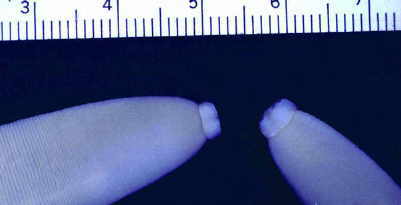Tapeworms: Life Cycle and Disease in Horses
by Robert N. Oglesby DVM
Introduction
Introduction
»
Description
»
Life Cycle
»
Effect on Host
»
Diagnosis
»
Treatment
»
More Info & Discussions
Various surveys have estimated the prevalence of tapeworm infection to be between 13% to 82% in horse populations around the world. The relation between cestodes and clinical disease is not clear. For years the organism was thought to be nonpathogenic as horses experimentally infected do not exhibit signs. However recent research has found correlations between tapeworm burdens and medical colic, surgical colic, enteritis, intestinal perforation and peritonitis. In 2002 an explosion of more effective safe products for the control of tapeworms occurred. This article contains information on life cycles, identification, disease, and control of this intestinal parasite.
Description
Introduction
»
Description
»
Life Cycle
»
Effect on Host
»
Diagnosis
»
Treatment
»
More Info & Discussions
Anoplocephaloides (formerly Paranoplocephala) mamillana, Anoplocephala magna, and Anoplocephala perfoliata are the three species of tapeworm found in horses. P. mamillana is found primarily in the duodenum and proximal jejunum, A. magna is found in the distal small intestine and A. perfoliata is found from the distal jejunum to the colons.
A. perfoliata appears to have a predilection for sphincters and orifices, and large numbers of tapeworms often are found clustered around the ileocecal junction. Cestodes (tapeworms) are seen most often in younger horses, although all ages may be affected.
Adult tapeworms vary widely in length depending on specie. The two smaller species are one to 3 inches (3 to 8 cm) long and about a 1/2 inch (1.2 cm) wide while A magna may be up to 35 inches (80 cm long). The head or scolex is globose without hooks and suckers are apparent as pits. There is a flap of scolex tissue (lappet) posterior to each sucker. Proglottids, the individual segments of the tapeworm, are much wider than long. Eggs 65 to 80-microns diameter, triangular to square in shape. Internally small oncosphere with six hooks and a pyriforme apparatus.
Life Cycle
Introduction
»
Description
»
Life Cycle
»
Effect on Host
»
Diagnosis
»
Treatment
»
More Info & Discussions
To read more on this topic become a member of
Horseadvice.com! Your membership gets you instant access to this and over 600 equine articles on our site. Other benefits of your membership include participation in our discussion boards and access to our one button PubMed search tool for each topic.
Horseadvice.com educates you to be a more knowledgeable horse owner which leads to healthier horses and save you money, we guarantee it. Come Join Us!
